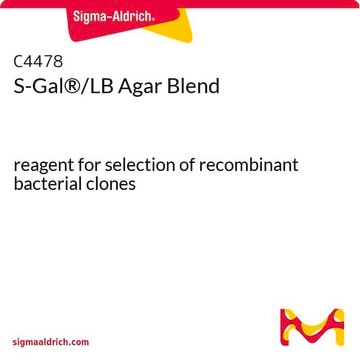S9811
S-Gal®
reagent for selection of recombinant bacterial clones
Synonym(e):
3,4-Cyclohexenoesculetin-β-D-galactopyranosid
About This Item
Empfohlene Produkte
Qualität
for molecular biology
Sterilität
non-sterile
Assay
≥95% (HPLC)
Form
powder
Löslichkeit
DMF: 50 mg/mL
Eignung
suitable for β-galactosidase test
Lagertemp.
room temp
SMILES String
OC[C@H]1O[C@@H](Oc2cc3OC(=O)C4=C(CCCC4)c3cc2O)[C@H](O)[C@@H](O)[C@H]1O
InChI
1S/C19H22O9/c20-7-14-15(22)16(23)17(24)19(28-14)27-13-6-12-10(5-11(13)21)8-3-1-2-4-9(8)18(25)26-12/h5-6,14-17,19-24H,1-4,7H2/t14-,15+,16+,17-,19-/m1/s1
InChIKey
HDJJDRXZHJRVGA-DIKXUDHVSA-N
Allgemeine Beschreibung
Anwendung
Leistungsmerkmale und Vorteile
- More intense color contrast than X-gal
- Excellent for use in automated colony counters
- Autoclavable for easiest use
- No need to make stock solutions
Sonstige Hinweise
formulation. A medium prepared with S-Gal® is moderately dark due to the presence of ferric ammonium citrate. This darker background often provides enhanced contrast for automated colony counting or isolation.
Prinzip
Rekonstituierung
Rechtliche Hinweise
Ähnliches Produkt
Signalwort
Warning
H-Sätze
Gefahreneinstufungen
Eye Irrit. 2 - Skin Irrit. 2 - STOT SE 3
Zielorgane
Respiratory system
Lagerklassenschlüssel
11 - Combustible Solids
WGK
WGK 3
Flammpunkt (°F)
Not applicable
Flammpunkt (°C)
Not applicable
Persönliche Schutzausrüstung
dust mask type N95 (US), Eyeshields, Gloves
Analysenzertifikate (COA)
Suchen Sie nach Analysenzertifikate (COA), indem Sie die Lot-/Chargennummer des Produkts eingeben. Lot- und Chargennummern sind auf dem Produktetikett hinter den Wörtern ‘Lot’ oder ‘Batch’ (Lot oder Charge) zu finden.
Besitzen Sie dieses Produkt bereits?
In der Dokumentenbibliothek finden Sie die Dokumentation zu den Produkten, die Sie kürzlich erworben haben.
Artikel
General protocols for growth of competent cells and their transformation (uptake of DNA).
Allgemeine Protokolle zum Wachstum kompetenter Zellen und ihrer Transformation (Aufnahme von DNA).
Protokolle
Technical Article on competent cells. Transformation is a process by which some bacteria take up foreign genetic material (naked DNA) from the environment.
Unser Team von Wissenschaftlern verfügt über Erfahrung in allen Forschungsbereichen einschließlich Life Science, Materialwissenschaften, chemischer Synthese, Chromatographie, Analytik und vielen mehr..
Setzen Sie sich mit dem technischen Dienst in Verbindung.







